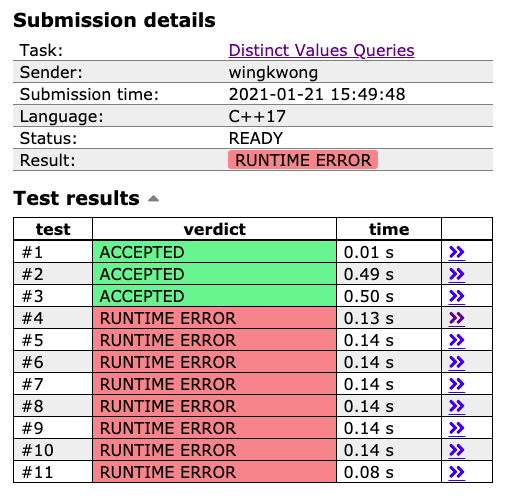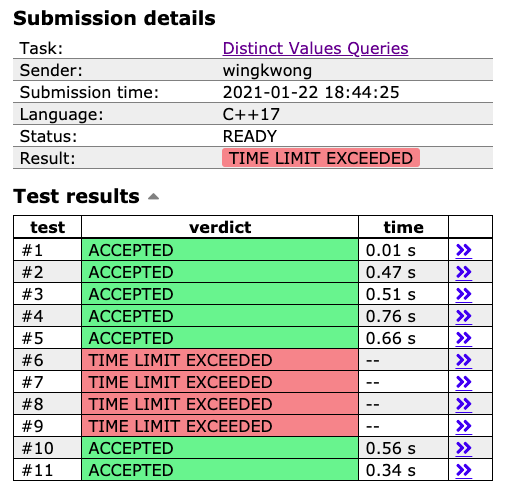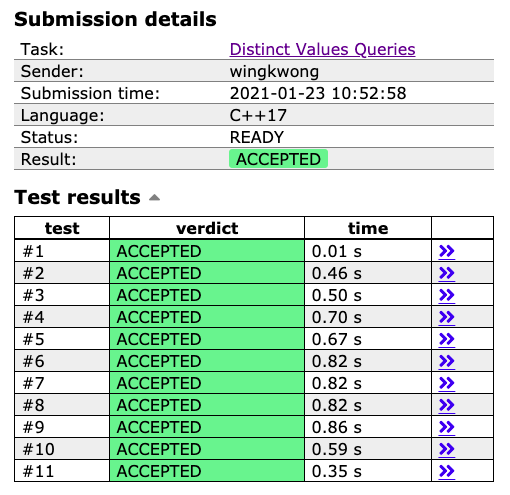Saturday, 23 January 2021
Solving Distinct Values Queries using Mo's Algorithm (Query SQRT Decomposition) with Hilbert Curve
## SQRT Decomposition
Square Root Decomposition is an technique optimizating common operations in time complexity O(sqrt(N)). The idea of this technique is to decompose the array into small blocks of size [N / sqrt(N)] = [sqrt(N)].
```cpp
b[0] : x[0], x[1], ..., x[block_size - 1]
b[1] : x[block_size], ..., x[2 * block_size - 1]
...
b[block_size - 1] : x[(block_size - 1) * block_size], ..., x[N - 1]
```
and precompute the answer for all blocks. Example: precalculate the sum of elements in block k.
```cpp
b[k] = min(N - 1, (k + 1) * block_size - 1) Σ i = k * block_size (x[i])
```
To calculate the sum of elements in a range [l, r], we just need the sum of [l ... (k + 1) * s - 1], [p * s ... r], and b[i].
```cpp
r Σ i = l (x[i]) = (k + 1) * block_size - 1 Σ i = l (x[i]) + p - 1 Σ i = k + 1 (b[i]) + r Σ i = p * s (x[i])
```
## Problem - Distinct Values Queries
You are given an array of n integers and q queries of the form: how many distinct values are there in a range [a,b]?
Input:
```
5 3
3 2 3 1 2
1 3
2 4
1 5
```
Output:
```
2
3
3
```
## Solution 1 - Using Mo's Algorithm
We can answer the range queries offline in O((N + Q) * sqrt(N)) using the idea based on square root decomposition. We need to answer the queries in a special order - answer all queries with L value in block 0 first, then answer all queries with L value in block 1, and so on. If they are in the same block, we then sort it by their R value.
```cpp
bool operator < (const mo &m) const {
// different block - sort by block
if(left / block_size != m.left / block_size) return left / block_size < m.left / block_size;
// same block - sort by right value
return right < m.right;
}
```
Then we need two functions for updating the answer - ``add`` and ``remove`` and freq[x] to keep track the frequency of a number x. For add function, if freq[x] is 0, and if we add 1 to it then x is now a distinct value. Similarly, we do it in reverse in ``remove`` function.
```cpp
void add(int x) {
if(!freq[x]) ans++;
freq[x]++;
}
void remove(int x) {
freq[x]--;
if(!freq[x]) ans--;
}
```
For each query [L, R], we can combine the precomted answer of the blocks that lie in between [L, R] in the given array. For example, given an array a[0 .. N - 1], we are asked to find out the sum in a range [L, R]. We first calculate the sum in a range [0, N - 1], if a query is like [1, N - 1], we simply substract the first element a[0] from the sum. Therefore, in general we have four cases to consider.
### Case 1: cur_left < query_left
We need to substract the sum from ``cur_left`` to ``query_left``.
```
[0, 1, 2, 3, 4, 5, 6, 7, 8, 9, 10, 11, 12, 13, 14, 15, 16, 17, 18, 19, 20]
^ cur_left ^ query_left
```
### Case 2: cur_left > query_left
We need to add the sum from ``cur_left`` to ``query_left``.
```
[0, 1, 2, 3, 4, 5, 6, 7, 8, 9, 10, 11, 12, 13, 14, 15, 16, 17, 18, 19, 20]
^ query_left ^ cur_left
```
### Case 3: cur_right < query_right
We need to add the sum from ``cur_right`` to ``query_right``.
```
[0, 1, 2, 3, 4, 5, 6, 7, 8, 9, 10, 11, 12, 13, 14, 15, 16, 17, 18, 19, 20]
^ cur_right ^ query_right
```
### Case 4: cur_right > query_right
We need to substract the sum from ``query_right`` to ``cur_right``.
```
[0, 1, 2, 3, 4, 5, 6, 7, 8, 9, 10, 11, 12, 13, 14, 15, 16, 17, 18, 19, 20]
^query_right ^ cur_right
```
where
- cur_left is the left pointer of the last query L
- cur_right is the right pointer of the last query R
- query_left is the left pointer of the query L
- query_right is the right pointer of the query R
```cpp
int cur_left = 0, cur_right = 0;
REPN(i, q) {
while(cur_left < Q[i].left) remove(x[cur_left++]);
while(cur_left > Q[i].left) add(x[--cur_left]);
while(cur_right < Q[i].right) add(x[++cur_right]);
while(cur_right > Q[i].right) remove(x[cur_right--]);
res[Q[i].idx] = ans;
}
```
However, [this solution](https://cses.fi/paste/0670b45afd08a4401804dc/) only passes 3 out of 11 test cases. The verdict for the rest of them is RUNTIME ERROR.

The reason is that each element can go up to 10 ^ 9. We cannot use frequency array for that. We also cannot use ``unordered_map`` as it will time out due to high constant factor. Therefore, an alternative is to use coordinate compression to map the large values to smaller one in the range [1, N] as N at most can be 2 * 10 ^ 5.
```cpp
int compressed = 1;
map compress;
REPN(i, n) {
// read the input
cin >> x[i];
// find the compressed value -> update x[i]
if(compress.find(x[i]) != compress.end()) x[i] = compress[x[i]];
// not found -> compress it and update x[i]
else compress[x[i]] = compressed, x[i] = compressed++;
}
```
Now [the revised solution](https://cses.fi/paste/d8a09d857905de4a182310/) gives you 4 TIME LIMIT EXCEED verdicts.

Let's rethink of the time complexity. When we sort all the queries, it will take O(QlogQ). For add(x) and remove(x), let the block size be S, it takes O((N / S) * N) calls for all blocks. If S is around sqrt(N), it takes O((N + Q) * sqrt(N)) in total. The solution can be all passed by changing the block_size to 555 and even more. Therefore, we can conclude that S = sqrt(N) doesn't always give you the best runtime. Moreover, we should also use ``const`` to define the block size instead of computing it in runtime as division by constants is optimized by the compliers. Is there a way to achieve a faster sorting? Yes. We can do it in O(N * sqrt(Q)) with [Hilbert Curve](https://en.wikipedia.org/wiki/Hilbert_curve).
## Solution 2 - Using Mo's Algorithm with Hilbert Curve
Hilbert Curve is a continuous fractal space-filling curve. Here's some examples.
Hilbert Curve with order = 1
```
|__|
```
Hilbert Curve with order = 2
```
__ __
__| |__
| __ |
|__| |__|
```
Hilbert Curve with order = 3
```
__ __ __ __
|__| __| |__ |__|
__ |__ __| __
| |__ __| |__ __| |
|__ __ __ __ __|
__| |__ __| |__
| __ | | __ |
|__| |__| |__| |__|
```
For each order N > 1, it traces out a miniature order N - 1, connecting from the end of the mini curve in the lower-left to the start of the mini curve in the upper-left and from the upper-right down to the lower-right and flip the quadrant to make the connection shorter. The pattern continues like that for higher orders. If we have a point about the halfway in the frequency line in Snake Curve, the locations of the point can be different wildly as N increases. However, with Hilbert Curve, the given point moves around less and less as N increases.
Therefore, we can revise our mo struct and the sorting compartor using Hilbert Order.
```cpp
struct mo {
int idx, left, right;
int64_t ord;
void set(int i, int l, int r) {
idx = i, left = l, right = r, ord = hilbert_order(l, r, 21, 0);
}
};
inline bool operator<(const mo &a, const mo &b) {
return a.ord < b.ord;
}
```
Here's the implementation of Hilbert Order function.
```cpp
inline int64_t hilbert_order(int x, int y, int pow, int rotate) {
if (pow == 0) return 0;
int hpow = 1 << (pow - 1);
int seg = (x < hpow) ? ( (y < hpow) ? 0 : 3 ) : ( (y < hpow) ? 1 : 2 );
seg = (seg + rotate) & 3;
const int rotate_delta[4] = {3, 0, 0, 1};
int nx = x & (x ^ hpow), ny = y & (y ^ hpow);
int nrot = (rotate + rotate_delta[seg]) & 3;
int64_t sub_square_size = int64_t(1) << (2 * pow - 2);
int64_t ans = seg * sub_square_size, add = hilbert_order(nx, ny, pow - 1, nrot);
ans += (seg == 1 || seg == 2) ? add : (sub_square_size - add - 1);
return ans;
}
```
We can see that [the final solution](https://cses.fi/paste/c16a9e1ae75872c6183147/) can pass all the test cases. With such technique, it works faster than the previous version, especially when N >> Q. Supposing we have a matrix with size 2 ^ k * 2 ^ k, if we divide it onto squares with size 2 ^ k - l * 2 ^ k - l, we need O(2 ^ k - l) time to travel between adjacent squares. We can process all queries in O(Q * 2 ^ k - l) = O(Q * N / sqrt(Q)) = O(N * sqrt(Q)).

At the end, it took me 74 attmepts to find out the most optimized solution.

## Conclusion
We can solve this problem using Mo's algorithm because it is an offline algorithm as we don't need to update the elements or the execution order of queries. We can utilize Hilbert Curve to speed up the program. It can also be solved using Segment Tree.
Subscribe to:
Post Comments (Atom)
A Fun Problem - Math
# Problem Statement JATC's math teacher always gives the class some interesting math problems so that they don't get bored. Today t...
-
SHA stands for Secure Hashing Algorithm and 2 is just a version number. SHA-2 revises the construction and the big-length of the signature f...
-
## SQRT Decomposition Square Root Decomposition is an technique optimizating common operations in time complexity O(sqrt(N)). The idea of t...
No comments:
Post a Comment